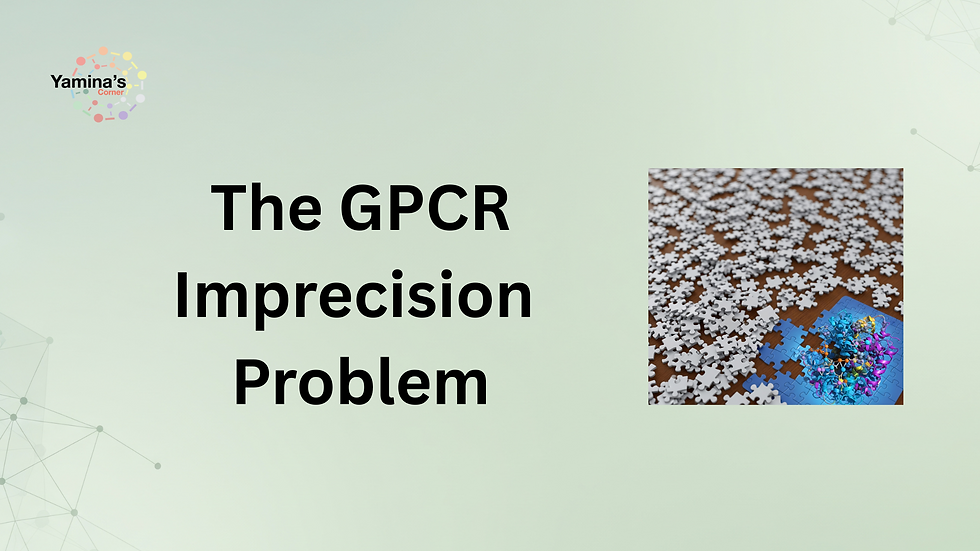The Imprecision Problem: Why Your GPCR Drug Discovery Program Is Off-Track Before It Even Starts
- Yamina's Corner

- Aug 20
- 3 min read

A GPCR program can have world-class science, top-tier talent, and millions in funding — and still fail. Not because the science is wrong. Not because the people aren’t brilliant. But because the program is run on duct tape and heroics instead of precision.
Your program isn’t slipping because of bad science — it’s bleeding money because your systems were broken before the first experiment ran.
And every time your Head of Biology spends each night copy-pasting data instead of thinking about the next experiment, your program is bleeding six figures in lost time and wasted salaries.
Brilliant minds doing low impact work is not a strategy. It’s a slow-motion car crash.
Hiring Won’t Save Your GPCR Drug Discovery Program
When a drug discovery program stalls, the default reflex is always the same: hire more people. Bring in a computational chemist. Add a data scientist. Surely more hands will move the needle.
But here’s the reality: even ultra-specialized experts can’t fix systemic dysfunction in their spare time. They’re hired for science, not for building operational scaffolding.
And when you chain your highest-paid scientists to repetitive admin work, you’re not solving problems — you’re multiplying them.
Every two-week delay in a DMTA cycle can burn through hundreds of thousands in salaries and overhead. That’s not a hiccup. That’s a hemorrhage.
Bad Data Management Is Undermining Your GPCR Drug Discovery Team
The real problem isn’t competence. It’s the absence of operational precision. Even flawless experiments collapse under sloppy systems.
A few familiar failure points:
Fragmented Data: GPCR programs spew data across files, folders, and inboxes. Without a unified drug discovery data management pipeline, teams waste hours cleaning, reconciling, and integrating before they can even think about analysis. A good ELN that pipes instrument outputs into a central hub — where QC, analysis, consumption and consolidation across assays — isn’t a luxury. It’s oxygen.
Undefined Protocols: “We’ll figure it out” is not a workflow. Without clear rules of engagement, communication becomes chaos, progress gets lost in Slack threads, and insights die in inboxes.
Ambiguous Decision Gates: Molecules advance or stall based on vibes, not criteria. That leads to premature investment in weak scaffolds or endless tinkering with dead ends.
These aren’t minor oversights. They’re cracks in the foundation. And cracks don’t stay small for long.
Build Precision Systems for GPCR Drug Discovery
The only way out for GPCR drug discovery programs isn’t more people or shinier assays. It’s a deliberate blueprint for precision.
This doesn’t mean an overnight overhaul. It means a commitment to continuous improvement — starting with the highest-friction gaps and working upward.
Plan, fix at the root, and stop fighting the same fire every week.
The payoff?
Progress that’s predictable, not reactive.
The Hidden Costs of Poor Drug Discovery Data Management
Stop pretending more hires or new assays will save you. They won’t.
Every DMTA cycle lost to fragmented data and sloppy processes costs your company hundreds of thousands of dollars. That’s not “part of the process.”
That’s a chaos tax — and you’re paying it in cash, time, and morale.
If you want your program to survive, you need a Blueprint for Precision. Not next quarter. Not after the next fire drill. Now.
Because the truth is harsh: in drug discovery, you don’t run out of science. You run out of money. And if your systems aren’t built for precision, you’ll run out fast.
👉 In Part 2, we’ll expose exactly how fragmented data cripples GPCR programs — and how to fix it before it sinks yours.
And if you’re already seeing the cracks? Don’t wait for Part 2. Reach out. Let’s build the systems now, before the next delay burns another half a million.
🚀 Book your free 30-minute precision audit — before your next DMTA cycle costs another $200K
Let’s unlock the momentum your GPCR program needs.
Or explore how we can work together:



Comments